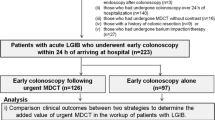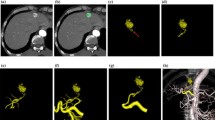Abstract
The utility of three-dimensional (3D) imaging with cone-beam computed tomography (CBCT) during interventional radiology (IVR) in colonic diverticular bleeding was compared to that of contrast-enhanced computed tomography (CECT). Additionally, to identify the responsible vessels in the absence of extravascular leakage using digital subtraction angiography, we examined the detection rate using software conventionally applied to transcatheter arterial chemoembolization (TACE). The 3D images obtained by CECT before IVR did not clearly show the destroyed vessels, whereas the 3D images obtained by CBCT during IVR clearly depicted the peripheral vessels. The TACE-assisted software identified the responsible vessels with a high probability, even in cases without extravascular leakage. CBCT could delineate vascular positions more accurately than CECT. Moreover, 80% of the responsible vessels could be delineated using the software; however, caution should be exercised as results may differ depending on the positioning of the region of interest.








Similar content being viewed by others
References
Nagata N, Niikura R, Aoki T, Shimbo T, Itoh T, Goda Y, et al. Increase in colonic diverticulosis and diverticular hemorrhage in an aging society: lessons from a 9-year colonoscopic study of 28, 192 patients in Japan. Int J Colorectal Dis. 2014;29:379–85. https://doi.org/10.1007/s00384-013-1808-4.
Wu LM, Xu JR, Yin Y, Qu XH. Usefulness of CT angiography in diagnosing acute gastrointestinal bleeding: a meta-analysis. World J Gastroenterol. 2010;16:3957–63. https://doi.org/10.3748/wjg.v16.i31.3957.
Nishikawa R, Morimoto Y, Hamaguchi T, Urata H, Terabe M, Miki C. A case of asymptomatic focal colonic necrosis after selective NBCA-TAE for the primary treatment of acute diverticular hemorrhage. J Japan Surg Assoc. 2016;77:1145–9.
Misu M, Inoue M, Ito N, Tsukada J, Nakatsuka S, Zinzaki M. Treatment strategy for lower gastrointestinal bleeding–from the standpoint of a radiologist–. J Abdom Emerg Med. 2018;38:831–4.
Strate LL, Gralnek IM. ACG clinical guideline: management of patients with acute lower gastrointestinal bleeding. Am J Gastroenterol. 2016;111:459–74. https://doi.org/10.1038/ajg.2016.41.
Walker TG, Salazar GM, Waltman AC. Angiographic evaluation and management of acute gastrointestinal hemorrhage. World J Gastroenterol. 2012;18:1191–201. https://doi.org/10.3748/wjg.v18.i11.1191.
Kinoshita M, Kondo H, Hitomi S, Hara T, Zako R, Yamamoto M, Hiraoka J, Takaoka Y, Enomoto H, Matsunaga N, Takechi K, Shirono R, Akagawa Y, Osaki K, OhnishiN TH. Ultraselective transcatheter arterial embolization with small-sized microcoils for acute lower gastrointestinal bleeding. CVIR Endovasc. 2021;4:28. https://doi.org/10.1186/s42155-021-00215-9.
Iwazawa J, Ohueo S, Hashimoto N, Mitani T. Feasibility of using vessel-detection software for the endovascular treatment of visceral arterial bleeding. Diagn Interv Radiol. 2014;20:160–3. https://doi.org/10.5152/dir.2013.13267.
Yamada R, Sato M, Kawabata M, Nakatsuka H, Nakamura K, Takashima S. Hepatic artery embolization in 120 patients with unresectable hepatoma. Radiology. 1983;148:397–401. https://doi.org/10.1148/radiology.148.2.6306721.
Miyayama S, Yamashiro M, Nagai K, Tohyama J, Kawamura K. Efficacy of automated tumor-feeder detection software using cone-beam computed tomography technology in transarterial targeted therapy. J Interv Rad. 2016;1:28–38. https://doi.org/10.22575/interventionalradiology.1.1_28.
Bapst B, Lagadec M, Breguet R, Vilgrain V, Ronot M. Cone beam computed tomography (CBCT) in the field of interventional oncology of the liver. Cardiovasc Intervent Radiol. 2016;39:8–20. https://doi.org/10.1007/s00270-015-1180-6.
Grosse U, Syha R, Ketelsen D, Hoffmann R, Partovi S, Mehra T, et al. Cone beam computed tomography improves the detection of injured vessels and involved vascular territories in patients with bleeding of uncertain origin. Br J Radiol. 2018;91:20170562. https://doi.org/10.1259/bjr.20170562.
Wildgruber M, Wrede CE, Zorger N, Müller-Wille R, Hamer OW, Zeman F, et al. Computed tomography versus digital subtraction angiography for the diagnosis of obscure gastrointestinal bleeding. Eur J Radiol. 2017;88:8–14. https://doi.org/10.1016/j.ejrad.2016.12.029.
Funabiki T, Orita T, Toyoda Y, Sato T, Kitano M. Transcatheter arterial embolization for gastrointestinal bleeding. J Abdom Emerg Med. 2014;34:1277–84.
Acknowledgements
We would like to thank Editage (www.editage.com) for English language editing. This manuscript was partly supported by the Akiyoshi Ohtsuka Fellowship of the Japanese Society of Radiological Technology for improving the English of a draft version of the manuscript.
Author information
Authors and Affiliations
Corresponding author
Ethics declarations
Conflict of interest
The authors declare that they have no conflicts of interest.
Ethical approval
All procedures performed in the study involving human participants were in accordance with the ethical standards of the Institutional Review Board (IRB, No: 20210416-04) and with the 1964 Helsinki declaration and its later amendments or comparable ethical standards. This article does not report any studies performed on animals.
Informed consent
Informed consent was obtained from all individual participants included in the study.
Additional information
Publisher's Note
Springer Nature remains neutral with regard to jurisdictional claims in published maps and institutional affiliations.
About this article
Cite this article
Nakano, M., Takano, K., Kaga, A. et al. The utility of using TACE-assisted software with CBCT in colonic diverticular bleeding without extravascular leakage. Radiol Phys Technol 15, 177–186 (2022). https://doi.org/10.1007/s12194-022-00658-2
Received:
Revised:
Accepted:
Published:
Issue Date:
DOI: https://doi.org/10.1007/s12194-022-00658-2




